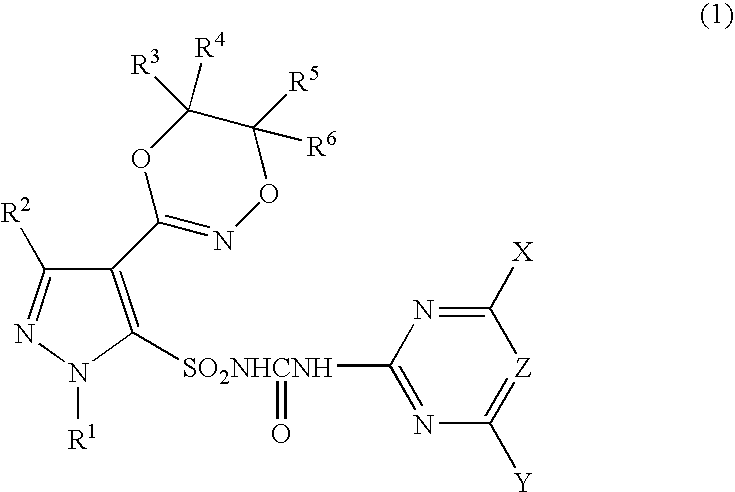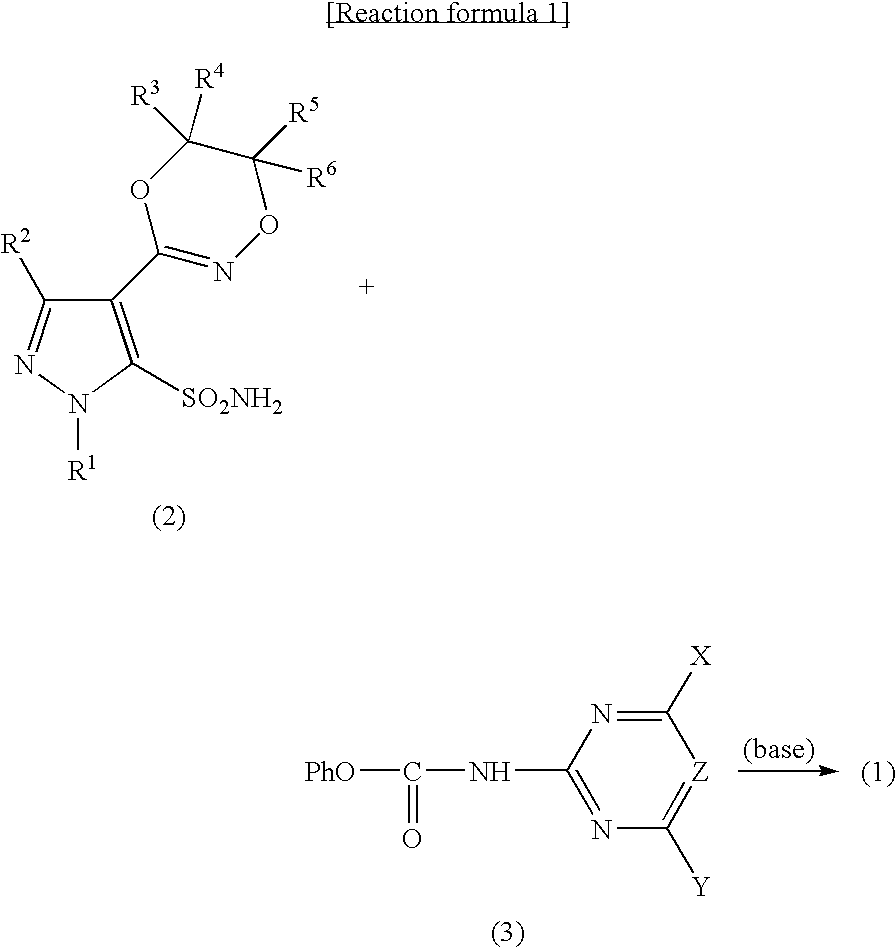Pyrazole Sulfonylurea Compound and Herbicide
a technology of pyrazole sulfonylurea and pyrazole sulfonylurea, which is applied in the field of pyrazole sulfonylurea compounds and agrochemicals, can solve the problems of not concretely revealing pyrazole sulfonylurea, and achieve excellent selective herbicidal compound, no crop injury, and excellent herbicidal
- Summary
- Abstract
- Description
- Claims
- Application Information
AI Technical Summary
Benefits of technology
Problems solved by technology
Method used
Image
Examples
example 1
Synthesis of N-((4,6-dimethoxypyrimidin-2-aminocarbonyl)-3-chloro-1-methyl-4-(5-methyl-5H,6H-1,4,2-dioxadin-3-yl)pyrazole-5-sulfonamide (Compound No. 1 of the present invention)
[0076]
[0077] In acetonitrile (8 ml), 3-chloro-1-methyl-4-(5-methyl-5H,6H-1,4,2-dioxadin-3-yl)pyrazole-5-sulfonamide (0.84 g, 2.2 mmol) and N-(4,6-dimethoxypyrimidin-2-yl)carbamic acid phenyl (0.59 g, 2.1 mmol) were dissolved, 1,8-diazabicyclo[5.4.0]-7-undecene (0.33 g, 2.2 mmol) was added, and stirred at room temperature for 1 hour. After water (8 ml) was added, the mixture was extracted with diethyl ether. The resulting aqueous phase was adjusted to pH 1 by adding 12% hydrochloric acid, and re-extracted with diethyl ether. The resulting diethyl ether solution was washed with water and saturated sodium chloride aqueous solution in that order, then dried over anhydrous sodium sulfate and the solvent was distilled off. The resulting residue was washed with n-hexane, and dried to obtain the aimed product (0.40 ...
example 2
Synthesis of N-((4,6-dimethoxypyrimidin-2-yl)aminocarbonyl)-3-chloro-4-(5-iodomethyl-5H,6H-1,4,2-dioxadin-3-yl)-1-methylpyrazole-5-sulfonamide (Compound No. 2 of the present invention)
[0078]
[0079] The procedure similar to that of Example 1 was carried by using 3-chloro-4-(5-iodomethyl-5H,6H-1,4,2-dioxadin-3-yl)-1-methylpyrazole-5-sulfonamide (0.090 g, 0.21 mmol) as a starting material to obtain the aimed product (0.10 g). Melting point 91-94° C. Proton nuclear magnetic resonance chemical shift values 8 (ppm) (in CDCl3) 3.28-3.42 (m, 2H), 3.89-4.05 (m, 7H), 4.04-4.12 (m, 1H), 4.31 (s, 3H), 4.56-4.60 (m, 1H), 5.79 (s, 1H), 7.43 (s, 1H), 12.93 (s, 1H).
example 3
Synthesis of N-((4,6-dimethoxypyrimidin-2-yl)aminocarbonyl)-3-chloro-4-(5,5-dimethyl-5H,6H-1,4,2-dioxadin-3-yl)-1-ethylpyrazole-5-sulfonamide (Compound No. 3 of the present invention)
[0080]
[0081] The procedure similar to that of Example 1 was carried by using 3-chloro-4-(5,5-dimethyl-5H,6H-1,4,2-dioxadin-3-yl)-1-methylpyrazole-5-sulfonamide (0.47 g, 1.5 mmol) as a starting material to obtain the aimed product (0.42 g). Melting point 189-191° C. Proton nuclear magnetic resonance chemical shift values δ (ppm) (in CDCl3) 1.41 (s, 6H), 3.78 (s, 2H), 3.97 (s, 6H), 4.30 (s, 3H), 5.78 (s, 1H), 7.58 (brs, 1H), 12.92 (brs, 1H).
PUM
| Property | Measurement | Unit |
|---|---|---|
| depth | aaaaa | aaaaa |
| temperature | aaaaa | aaaaa |
| temperature | aaaaa | aaaaa |
Abstract
Description
Claims
Application Information
 Login to View More
Login to View More - R&D Engineer
- R&D Manager
- IP Professional
- Industry Leading Data Capabilities
- Powerful AI technology
- Patent DNA Extraction
Browse by: Latest US Patents, China's latest patents, Technical Efficacy Thesaurus, Application Domain, Technology Topic, Popular Technical Reports.
© 2024 PatSnap. All rights reserved.Legal|Privacy policy|Modern Slavery Act Transparency Statement|Sitemap|About US| Contact US: help@patsnap.com










